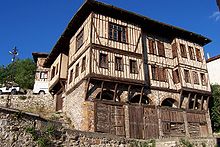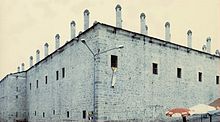Safranbolu
| Safranbolu | ||||
|
||||
| Basic data | ||||
|---|---|---|---|---|
| Province (il) : | Karabuk | |||
| Coordinates : | 41 ° 15 ′ N , 32 ° 41 ′ E | |||
| Residents : | 50,797 (2018) | |||
| Telephone code : | (+90) 370 | |||
| Postal code : | 78600 | |||
| License plate : | 78 | |||
| Structure and administration (as of 2019) | ||||
| Mayor : | Elif Köse ( CHP ) | |||
| Website: | ||||
| Safranbolu County | ||||
| Residents : | 67,042 (2018) | |||
| Surface: | 750 km² | |||
| Population density : | 89 inhabitants per km² | |||
| Kaymakam : | Gokhan Azcan | |||
| Website (Kaymakam): | ||||
Safranbolu (formerly Dadibra , Zalifra ) is a small town in northern central Anatolia in Turkey and the capital of a district in the province of Karabük ; it is 10 km north of Karabük. The district of the same name consists of the district town of 60 villages ( Köy ), of which Bostanbükü (5,535), Yaziköy (2,438) and Karit (1,643 Ew.) Are the largest. The villages make up about 24 percent of the district's population.
Because of its cityscape, which is characterized by half-timbered houses , Safranbolu has been on the UNESCO World Heritage List since 1994 . A delicacy of saffron bolus is “ Lokum ”, a syrup-based sweet.
Before the great military conflicts between 1919 and 1922, which the Turkish national troops under the command of Mustafa Kemal Pascha, later known as Ataturk , fought against the Greek invasion army, the inhabitants of Safranbolu were for the most part Greek: They settled in the Following the Treaty of Lausanne of July 24, 1923, she moved from her home country to Greece.
Origin of name
There are various hypotheses about the name Safranbolu. The author Nişanyan gives the previous name as Theodoroupolis and thus names a place from the time of the Eastern Roman Empire . From this, Sadrabolu and then Safranbolu emerged. According to Bilge Umar, however, Dadybra was the original form. In adaptation to the Turkish language, it was first Zalifre, then later Zağfiran Borlu. In any case, it is certain that the name has nothing to do with saffron.
City topography
The city is divided into three parts, the old city center Çarşi Bölgesi, the modern center Kiranköy Bölgesi and the upper town of Bağlar, which once served as a kind of summer retreat. The lower and upper parts in particular have numerous traditional houses and are therefore one of the few places in Turkey to have retained a seemingly medieval atmosphere. These residential buildings are usually three-story: On a ground floor made of stones, there are two further floors, which consist of plastered timber framing, which is composed of very narrow compartments. Safranbolu looks like an open-air museum for traditional Turkish, but here Greek-influenced architecture.
The lower town
This oldest part of the city was originally a stage stop on one of the branches of the so-called Silk Road . For 700 years Safranbolu was an important base for the east-west trade caravans. The mighty building of the caravanserai in the middle, called "Cinci Han", testifies to this function . Its fortress-like character is marked by narrow windows and loopholes. Inside there is a wide courtyard with two floors of arcaded arches, in the middle of which there is a fountain. Today the building houses a boutique hotel, the guest rooms of which were once used by merchants to accommodate their goods. The pack animals were on the ground floor in a large hall. The manager in charge of the caravanserai owned an apartment in the tower rising above the single gate.
In the immediate vicinity is the artisan quarter with the bazaar, where modern shops are available, in which, in addition to souvenirs, saffron and other medicinal herbs are sold. Individual craftsmen belonging to the traditional guild of blacksmiths also work here. Forging iron is a traditional source of income in Karabük Province . In the old workshops, horseshoes, iron nails, bars and other metal objects are forged.
The houses around the bazaar are overlooked by two mosques , the former of which was donated by Grand Vizier Mehmed Köprülü , who was in office between 1656 and 1661 , after whom it bears its name; there is a Roman sundial in its forecourt. The second mosque from the late 18th century is named after its founder Izzet Mehmet Pascha (1743–1812), who was a grand vizier from 1794 to 1798 and came from Safranbolu himself; its sarcophagus-like Türbe (grave monument) can be seen in the courtyard. The interior decoration of the mosque is reminiscent of Central European Rococo. A library also belongs to the adjoining building complex. The large building of the hamam , the Turkish bath, rises up between the two mosques , with several domes crowning the roof. There is also the Dağdelen Mosque (also from the 18th century) and the Kalpak or Lütfiye Mosque, which stands on an arch above the Safranbolu River and was only built in the 19th century. A little above the lower town is a classicist palace from the 19th century, which used to be the town hall, but now houses the town museum. From here there is a beautiful panorama of the historic center.
Middle and upper town
The middle part of the city, which adjoins to the north, is the center of busy modern life. Here is another, rather inconspicuous mosque. Even further up, on the castle hill towering over the whole town, with the Seljuk fortress, the upper town extends with its loosely standing houses in the style of the lower town center: In the hot season, these served as villa-like summer seats for the residents of old Safranbolu. From the fortress hill itself, you can enjoy a panoramic view of the entire city.
Development of the population
The following table shows the annual population development of the city at the end of the year after updating by the address-based population register (ADNKS) introduced in 2007. The last (lowest) figure comes from the 2000 census .
| year | Residents |
|---|---|
| 2018 | 50,797 |
| 2017 | 48,382 |
| 2016 | 46,924 |
| 2015 | 46,360 |
| 2014 | 43,975 |
| 2013 | 42,813 |
| 2012 | 43,060 |
| year | Residents |
|---|---|
| 2011 | 41,954 |
| 2010 | 49.014 |
| 2009 | 39,669 |
| 2008 | 37.092 |
| 2007 | 38,334 |
| 2000 * | 31,697 |
Surrounding area saffron bolus
In the immediate vicinity you can visit the natural cave Bulak Mağarasi, the part of which to be visited is around 400 meters long, while the entire length is a little over six kilometers. The cave extends over three levels, the middle of which is traversed by a stream that forms a waterfall that is around 15 meters high.
In the other direction one reaches an aqueduct from Ottoman times, the Inceköprü Safranbolu aqueduct. In a bent path, it crosses a stream that flows in a picturesque deep valley. Today, outdoor events are held here.
The famous saffron crocuses are grown in the wider area of the city, especially today near Davutobasi, a village 20 km from Safranbolu.
Attractions
- Traditional Ottoman houses with a rectangular pool of water (havuz) in the house
- Residence of Suleyman Pasha
- Greek City Hall
- Cinci hanı , a 17th century caravanserai
- Cinci hamam , a 17th century hammam
- Su Kemeri , a Byzantine aqueduct seven kilometers north near the village of Incekaya
literature
- Häusler, Wolfgang: Safranbolu, life in a small Turkish town , Graz 1996. ISBN 3-85365-145-3 .
- Günay, Reha: Tradition of the Turkish House and Safranbolu Houses , Istanbul 1998. ISBN 975-7438-68-5 .
- Günay, Reha: Safranbolu Houses , Istanbul 2002. ISBN 975-859962-3 .
- Günay, Reha - Bonsdorff, Mikko - Kaila, Panu - Gökçüoglu Evi: A House in Baglar, the Summer Town of Safranbolu , Tampere University of Technology 1995. ISBN 951-722-313-7 .
Web links
- Information from the Turkish Ministry of Culture and Tourism ( Memento from March 4, 2006 in the Internet Archive )
- Website of the Safranbolu Guide
- Entry on the UNESCO World Heritage Center website ( English and French ).
- Videos from Safranbolu in the online archive of the Austrian Mediathek (metal processing)
Individual evidence
- ↑ a b Nufusune.com , accessed April 15, 2019
- ↑ Sevan Nişanyan : Adini unutan Ülke. Türkiye'de Adı Değiştirilen Yerler Sözlüğü. Istanbul 2010, p. 181
- ↑ Bilge Umar: Türkiye'deki Tarihsel Adlar. Istanbul 1993, p. 194
- ^ Central Dissemination System from TÜIK , accessed on October 20, 2018
- ↑ 2000 Genel Nüfus Sayımı, TÜIK , accessed on October 20, 2018







